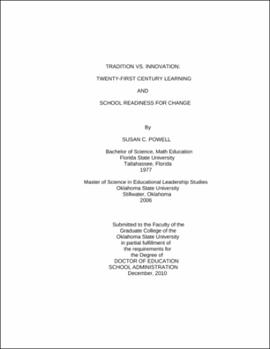| dc.contributor.advisor | Krumm, Bernita | |
| dc.contributor.author | Powell, Susan C. | |
| dc.date.accessioned | 2013-11-26T08:34:49Z | |
| dc.date.available | 2013-11-26T08:34:49Z | |
| dc.date.issued | 2010-12 | |
| dc.identifier.uri | https://hdl.handle.net/11244/7539 | |
| dc.description.abstract | Scope and Method of Study: The purpose of this case study was to analyze the willingness of staff within one district's three secondary schools to change, and to determine the schools' readiness to transition from traditional instructional practice to Twenty-first Century learning. Because of the complexity of organizational change, Diffusion of Innovations Theory was the theoretical framework to analyze staff willingness to change. Based on research findings, inferences were made about the three schools' readiness for Twenty-first Century learning. | |
| dc.description.abstract | Findings and Conclusions: | |
| dc.description.abstract | A number of conclusions can be drawn from this study. First, Diffusion of Innovations as a theoretical framework not only clarifies the "process by which an innovation is communicated through certain channels over time among the members of a social system" (Rogers & Sinhal, 1996), it also explains the adoption of new ideas in educational settings. DOI is a useful resource for district administrators and principals needing to understand the complexity of organizational change, to analyze staff willingness to change, and to determine readiness for school reform. | |
| dc.description.abstract | Similarly, the Practitioners' Survey is a practical instrument for determining the distribution of DOI adopter categories. Analysis of the distribution of adopters, especially innovators, early adopters and laggards, is helpful not only for evaluation of staff willingness to change, but also whether schools have enough teacher leaders to implement new ideas, to communicate with peers about such ideas, and to guide the adoption process. In addition, the comparison of the distribution of adopters among multiple schools can help district leaders allocate scarce resources to the most innovative schools. | |
| dc.description.abstract | However, one weakness of the DOI framework is that it does not facilitate contribution from laggards or give them an opportunity to participate in the communication process. The evolution of leadership in the Twenty-first Century points to an increasing expectation of followers that they will not be pushed. They want to influence organizational decisions. Today's employees want collaborative leadership and they want a voice in the change process. If teachers do not have voice in their school environment, how can they feel like they can make a difference in today's high stakes, test driven educational system? When teachers have a say in school decisions, they tend to believe that the staff has strong beliefs, collective capability, and the ability to effect change. Administrators will benefit greatly if they recognize the role that teacher voice plays in leading change. | |
| dc.format | application/pdf | |
| dc.language | en_US | |
| dc.rights | Copyright is held by the author who has granted the Oklahoma State University Library the non-exclusive right to share this material in its institutional repository. Contact Digital Library Services at lib-dls@okstate.edu or 405-744-9161 for the permission policy on the use, reproduction or distribution of this material. | |
| dc.title | Tradition vs. innovation: Twenty-first century learning and school readiness for change | |
| dc.contributor.committeeMember | Harris, Ed | |
| dc.contributor.committeeMember | Brown, Pamela | |
| dc.contributor.committeeMember | Kearney, Kerri | |
| osu.filename | Powell_okstate_0664D_11194.pdf | |
| osu.accesstype | Open Access | |
| dc.type.genre | Dissertation | |
| dc.type.material | Text | |
| dc.subject.keywords | change | |
| dc.subject.keywords | diffusion of innovations | |
| dc.subject.keywords | innovation | |
| dc.subject.keywords | leadership and change | |
| dc.subject.keywords | school reform | |
| dc.subject.keywords | twenty-first century learning | |
| thesis.degree.discipline | Teaching and Curriculum Leadership | |
| thesis.degree.grantor | Oklahoma State University | |
